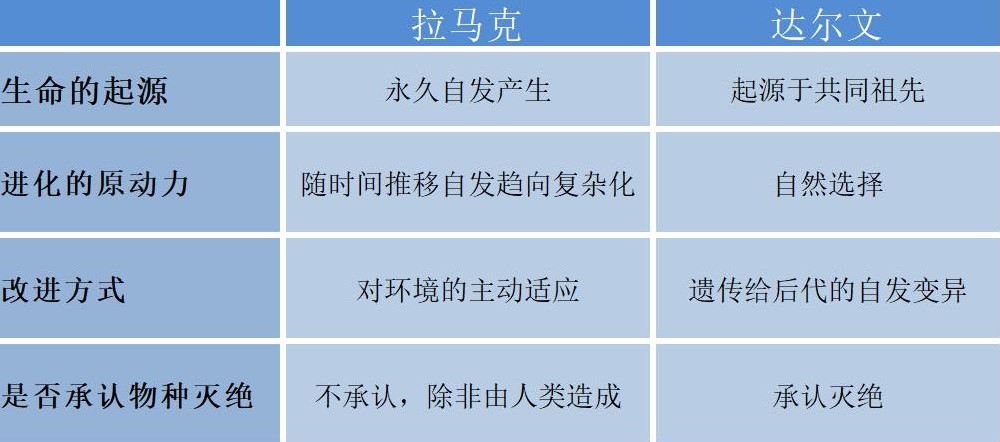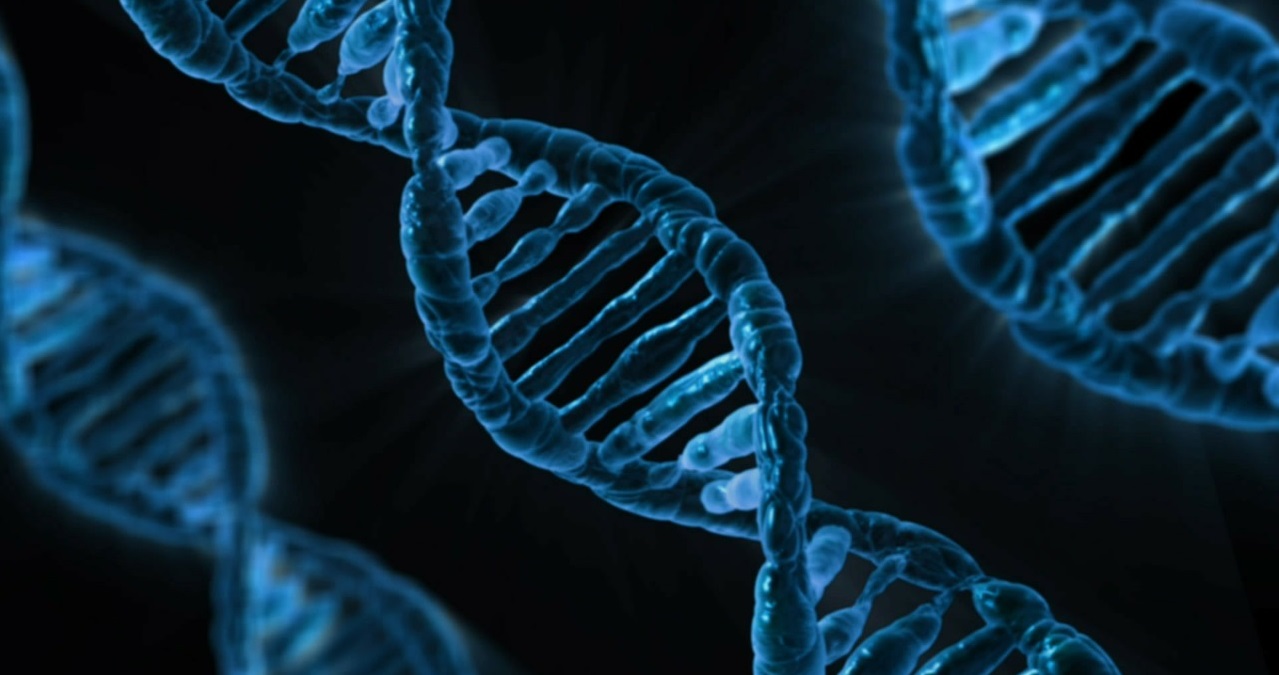拉马克和达尔文:两种对待生命世界的不同看法

在过去的二十年中,关于所谓的表观遗传现象,即环境诱导基因表达发生变化,并暂时传递给后代,这方面已经积累较多的科学数据。这导致一些作者将其与拉马克主义相关联,有些人甚至提出了将拉马克和达尔文的理论结合起来,用以阐述一种新的综合进化论。学者们通过对这两种理论的基本原理进行比较,发现二者对生命世界的看法存在巨大的分歧,且无法调和。但是,表观遗传现象的深入研究势必会丰富达尔文理论。
1.拉马克与达尔文的冲突与困惑
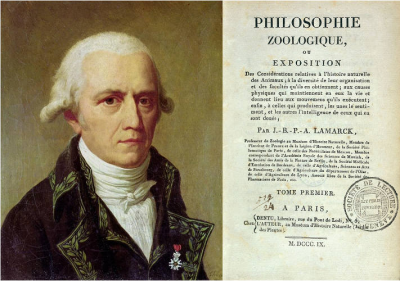
1800年,法国伟大的博物学家让-巴蒂斯特·拉马克(Jean-Baptiste Lamarck,1744-1829)提出了第一个连贯且得到有力支持的生命进化理论,并于1809年在他的著作《动物学哲学》中发表(图1)。
五十年后,查尔斯·达尔文(Charles Darwin,1809-1882)在英国出版了《物种起源》一书,在其中阐述了他的关于生物通过“后代渐变”(图2)(见焦点文章达尔文)进行物种转化的理论。

这两位伟大的博物学家的理论之间的最大共同点是都肯定了进化这一事实的存在,这与当时普遍接受的创世论相悖。但他们对生命世界中生命起源和进化机制等基本问题上存在根本分歧。诞生于20世纪初的遗传学能够为达尔文理论提供的知识非常有限。在20世纪40年代,遗传学的发展使现代综合进化论或新达尔文主义的产生成为可能。此时,或许人们会认为,拉马克主义和达尔文主义之争已经结束。
然而,事实并非如此,两种理论至今仍然存在冲突和困惑。对于公众来说,进化论通常以拉马克的方式来理解,但并非所有人都能够接受它[1]。拉马克认为,进化或多或少是在环境的直接影响下发生的。达尔文的理论则强调,偶然发生的遗传变异可能是重要生物转化的基础(见下文),这是常识。
令人惊讶的是,生物学家、哲学家和科学史学家之间也存在着这些冲突和困惑。这些冲突通常与对达尔文主义的反感相关,其动机不具有科学性(参见进化论:误解和抵抗)。困惑是由误解或解释困难引起的。拉马克关于生命诞生的一些著作尤其如此,其内容即使不是矛盾的,也有些模棱两可[2]。
在过去的20年里,随着基因组的表观遗传印记愈发重要,这种情况变得更加突出,本百科全书的几篇文章对其进行了讨论(参见适应:应对环境挑战;表观遗传学,基因组及其环境;生物体对环境的适应)。简而言之,这些印记涉及DNA(或其周围的蛋白质)的化学变化,但不会改变核碱基的序列(因此它们不是基因突变)并且是可逆的。在适应性意义上,它们通常由压力情况触发并影响基因表达。它们可以遗传给后代几代,称为表观遗传记忆或跨代效应。这类现象早已为人所知,自本世纪初以来一直是新的科研热点(参见表观遗传学、基因组及其环境)。
这种跨代效应虽然是短暂的,但可能会让人联想到后文所讨论的后天特征的遗传。这种现象经常被错误地认为是拉马克理论的主要特征。这导致生物学家重新发起了关于是否可能更新这一理论的讨论。有些人甚至提出了综合两种进化论以形成一种新理论的想法。但显然二者之间存在的巨大差异并不支持这种想法的实施。
我们在这里将严格从生物学角度讨论这个主题,通过比较这些理论的基本原理和由此产生的看待生命世界的观点,特别是关于生命起源和物种转化机制的观点。劳伦特·洛伊森(Laurent Loison)和弗朗西丝卡·梅林(Francesca Merlin)的文章从科学史和科学哲学的角度解决了这个问题,二人的文章也可以在百科全书[3]中找到。
2.生物的起源及其谱系关系
在拉马克看来,“最简单”或“最不完美”的有机体总是以“自然发生”或“直接生成”的形式出现。他在《动物学哲学》中写道:“大自然在其前进的道路上,从形成最简单的组织体开始,并且这一过程每时每刻都在发生[本文作者划线标注],也就是说,它只是直接形成了那些最早最简单的生物,这些生命形式已由自发世代的表达指定”。
顺便提一下,出于我们目前对活细胞的异常复杂性和生命起源最基本的了解,这种永久自发产生的想法令人感到可笑。以及生命有机体的修饰语“简单”(阅读文章热爱天文学的地质学家所见的生命起源;生命出现的时代:40亿年前地球海洋的化学和第一个细胞的起源:工程师的观点)。
拉马克猜想这些原始生物随着地质时间的推移而逐渐变得复杂,最终演变为所有现有生物。拉马克认为,生物的复杂性与生物自身所具有的趋于完美的特性密切相关,它是生物的固有属性,我们在后文会介绍这个属性。
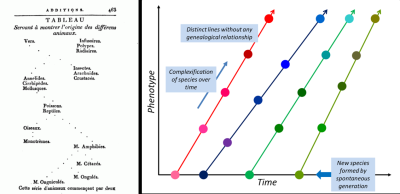
左边是他的著作《动物学哲学》(1809)中的图表,显示了物种日益复杂的情况。右侧,表示生物体随时间的进化。由于自然发生,生物随着时间的推移变得更加复杂。两条不同的线之间没有亲缘关系。[来源:摘自本书(公有领域);图:JC布雷利亚诺(JC Bregliano)](Phenotype 表型;Time 时间;Distinct lines without any genealogical relationship没有任何谱系关系的线条;Complexification of species over time物种随时间的复杂化;New species formed by spontaneous generation自然发声形成的新物种)
因此,对于拉马克而言,自发的演化会经常发生,并且每次复杂化的过程都是会重复的(尽管在这两点上他的著作表述有些模棱两可)。因此,自地球起源以来,最简单的生物会自发地从惰性物质中出现,并会反复启动平行进化的序列(图3)。这在每一行中,都存在亲子关系,从最简单到最复杂,但这些线之间不能有宗谱关系。
拉马克还假设原始动植物以两种独立的方式出现。并且认为动物的出现有两条不同的路径。一个相对较短,从当时所谓的“纤毛虫”(单细胞微生物)开始,另一个较长,从最简单的蠕虫开始,一直延伸到脊椎动物(图3)。简而言之,在拉马克理论中,生命世界的谱系图将由多个连续且独立的线组成。不会有一个共同的祖先。
达尔文在《物种起源》中没有谈到生命如何在地球上出现,他所生活的那个时代的现有知识限制了他对生命的出现进行解读的可能性。但有时在他会在与友人的通信中提到自己的观点,特别是在1871年在给他最好的朋友约瑟夫·胡克的一封信中说:“人们常说,孕育生命所需的所有条件都已经存在,这些在当时可能确实已经存在。但是如果(哦!多么大胆的假设!)我们的生命可以在某个温暖的小池塘里孕育,有各种氨和磷酸盐,以及光、热、电等条件存在,产生的蛋白质等化合物有条件通过化学方式形成,并准备进行更复杂的变化,在今天,这种物质会立即被吞噬或吸收,这在生物形成之前是不可能的。”
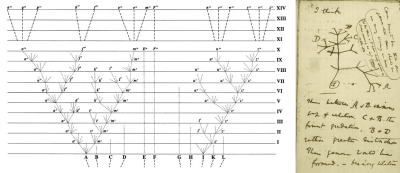
所以对达尔文来说,生命的出现只能发生在一个仍然是非生物的世界中,其过程非常缓慢。他拒绝永久自然发生的想法,这是自巴斯德[4] 以来被普遍接受的想法。因此,地球上的所有生物都源自这种共同祖先的生命形式(图4)。在《物种起源》的结尾,他写道:“……所有曾经生活在这个地球上的有机生物都是从某种原始形式发展来的,这种原始的方式带来了最早的生命。”
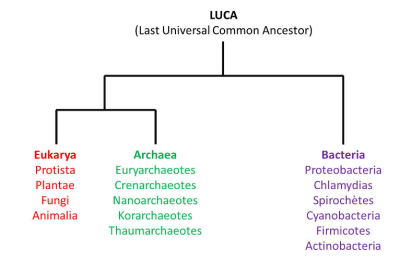
[来源:公有领域]。(Last Universal Common Ancestor 共同祖先;Eukarya 真核(生物)域;Protista 原生生物(界);Plantae植物界;Fungi 真菌界;Animalia 动物界;Archaea 古生菌;Euryarchaeotes 古菌门;Crenarchaeotes 生菌门;Nanoarchaeotes 纳米古菌;Korarchaeotes 科拉古菌门;Thaumarchaeotes 奇古菌门;Bacteria 细菌;Proteobacteria 变形菌门;Chlamydias 衣原体;Spirochètes 螺旋体;Cyanobacteria 蓝藻;Firmicotes 厚壁菌;Actinobacteria 放线菌)
这一观点与现代科学研究结果完全一致,现代科学研究试图了解这种原始祖先形式的特征,称为LUCA,即共同祖先(Last Universal Common Ancestor)(图5)。关于这个主题,我们可以查阅法国科学院于2013年组织的特别研讨会“生命的起源”的视频[5]。
因此,我们可以看到就生命的起源而言,拉马克和达尔文的理论是基于对生命世界的两种截然不同的看法。
二者理论之间至少还有另外两个重要的区别。由于二者都涉及生命的进化方式,因此它们交织在一起错综复杂。但为了表述清楚,我们将分别介绍它们。
3.进化转变的机制
我们现在介绍这两种理论真正的核心内容。拉马克认为,作为物种转化根源的个体变异是外部环境的影响下产生了“需要”,而“需要”本身就是“行动”或“努力”的起源,而这种“行动”或“努力”将成为生物的“习惯”。我们在此引用他的话:“第二个结论是我自己的:它假设环境对生物习惯的影响,然后是习惯对动物身体各部分情况的影响,甚至是对组织状况的影响,每只动物都可以在其身体各部分和组织中发展出可能对其生存非常重要的变化。”
在《动物学哲学》的第七章中,它陈述了第一条定律:“在任何尚未达到其发育终点的动物中,对器官频繁和持续的使用会使该器官逐渐加强、发展、扩大……;而若这种器官有持续的缺陷,其功能则会在不知不觉中被削弱和减退,进而逐渐减少其功能,最终使其消失”。
在讨论植物的进化机制时,拉马克则提出了环境对有机体的影响更为直接,因为对于植物而言不存在所谓的努力和习惯!因此,在拉马克的理论中,变化总是或多或少直接在外部条件作用下产生。
自20世纪初发现基因突变以来,新拉马克主义者不得不在原有理论的基础上整合突变是变异根源这一观点。然后他们认为这些变异必须是特定的基因在环境的引导下产生的,以使有机体适应其环境。但这个想法与自20世纪40年代以来进行的所有实验研究相矛盾。一个美国团队在1997年发表了最新的也是最具示范性的一篇文章[6],我们稍后再讨论这个问题。
基于这些诱发产生的变异,物种的转变将沿着复杂性增加的趋势变化,至少在动物中是这样。这种趋势将在演变中起到“驱动力”的作用。但这种趋势从何而来?它应该是生物的内在属性,会不可逆转地将生物体的结构变得更加复杂。因此,这是无需解释的自然法则。顺便提一下,按照同样的逻辑,拉马克不相信物种会灭绝,除了那些被人类活动毁灭的物种。他认为,物种的转变是生物自身的复杂化,但生物本身不会灭绝。
然而,拉马克十分支持唯物主义,并经常强调生命只应遵循物理定律。必须承认,拉马克在他的著作中经常提到“造物主”有一定政治投机的意味(拿破仑不能接受上帝在生命产生和演化过程中完全不起作用!)。然而在他看来,这种不断趋向复杂的趋势,是生物独有的属性,是对生命主义哲学学说的一个特有的强调,该学说确立了一个与思维灵魂和身体的理化性质不同的另一个重要原则,它支配着生命现象(安德烈·拉兰德(André Lalande)的定义)。
应该注意的是,这种复杂化的趋势,以及环境对生物形态变化的影响,都起到了抵抗外来危害的作用。因此,拉马克主义所表述的物种转化中的随机程度十分有限。这就是他的理论吸引了许多生物学家和科学哲学家的原因。
而达尔文强烈反对外部条件是引起物种性状改变的原因这一观点。在《物种起源》的导言中,他写道:“自然学家不断将外部条件,如气候、食物等视为变异的唯一可能原因。正如我们将在下文中看到的那样,这可能在一定程度上是真的;但是,啄木鸟的身体结构(例如啄木鸟的脚、尾巴、喙和舌头)非常适合在树皮下捕捉昆虫,将这种高度契合的形成仅仅归因于外部条件是荒谬的。……”他还拒绝一股力量推动复杂性增加的观点,他认为这很“愚蠢”。
在达尔文理论中,“自发的和偶然的”遗传变异发挥主要影响,自然选择也从中起作用(参见图4;参见进化论:误解和抵抗)。正是后者扮演了进化“引擎”的角色,偶然发生的变异只是为进化提供基本的“材料”。达尔文写道:“我相信自然选择一直是主要的但不是唯一的修改手段”。
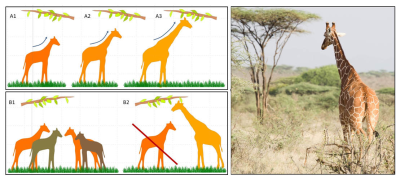
在拉马克(A1到A3)中,这种转变发生在导致“需求”的外部环境的影响下:在这里,长颈鹿的脖子会变长(箭头),以便它可以以树木的高叶为食。对于达尔文来说,一个物种内“自发的和偶然的”遗传变异将增加其多样性(B1),这就是自然选择的基础:在长颈鹿的例子中,长颈鹿的祖先存在着颈部长短的差异,而环境(树枝的高度)将成为选择的屏障;拥有长颈的个体将更有效地繁殖,因为他们吃得更好(B2)。基于 Solarist的图画绘制的图表(自己的作品)[知识共享许可协议 BY 3.0],通过维基共享资源。[来源:照片©雅克·乔亚德(Jacques Joyard)]
因此,达尔文的理论所表述的进化过程并不存在任何决定性。偶然发生的变异和选择相结合的结果是,一个种群在给定时间和给定环境中的最佳适应,很大程度上是具有危害性的(见焦点文章进化的起伏:小数量的作用)。就其本身而言,这个过程并不意味着任何复杂性的倾向,更不用说趋于完美了。在此期间生物体可能会获得新功能,但也可能会失去已有的某些功能,从而使身体结构更加简化,这种现象通常在各种寄生虫中被观察到。不用说物种的灭绝,即使整个动物群的灭绝,拉马克都不接受。达尔文进化论者欣然说,如果进化要重新开始,没理由会重复之前同样的路。拉马克和达尔文的观点之间再一次发生了巨大分歧。。
4.将变化传递给后代
让我们回到已经提到的关于后天特征的继承问题上,这个表达通常与拉马克的理论有关,但实际上它的出现要比拉马克的理论要晚得多。这第三点在两种理论之间的差异远小于前一种,但对于遗传学中积累的知识仍然很重要。
在生物学家或科学史学家的笔下,这种后天特征的继承有时表现为拉马克和达尔文理论之间的类比,有时是它们之间的唯一主要区别。因此,非专业人士很难自行理解,我们在此试着澄清一下。
首先,让我们回顾一下,在拉马克和达尔文的时代,我们对遗传机制一无所知[7]。所以我们必须试着理解为什么“狗不会生猫”诸如此类的问题。
由于在拉马克主义中,变异是在环境的影响下发生的,所以它们从一开始就不是可遗传的(今天我们说:它们不是遗传的,而只是表型的)。然而,要让它们在物种的转化中发挥作用,它们必须是可遗传的,因此拉马克第二定律:“由于其种族长期生存环境的影响,自然会导致其失去或获得的一切会一代一代地保留给后代,前提是两性或产生这些新个体的人所共有的。”
因此,在环境影响下获得的性状将传递给后代。这不是拉马克特有的假设,他采用了一个在他那个时代已经被考虑过的想法,并且自古以来就被认为是不言而喻的,但却与上个世纪进行的研究相矛盾。
达尔文并不完全排斥在环境直接影响下获得的某些性状会遗传的可能。他甚至论述了一个非常古老的假设,即“泛生论”理论(“泛生论”理论是受古代思想启发并由达尔文提出来解释生物遗传、繁殖和发育的假说。非常小的粒子(gemmules)将由不同的身体部位产生并传播到生殖器官。达尔文本人认为这是非常推测性和临时性的。),这种假说甚至可追溯到希波克拉底时代(公元前460-370年)。泛生子假说能够解释一般性的遗传,也可以解释后天特征的遗传。但对达尔文来说,这充其量只能是次要机制。关于泛生论,达尔文认为,这个假设大都是推测性和暂时性的。他认为物种转化过程中唯一有意义的变异是那些可被传递的变异,现在被称为“遗传”(参见稳定性和变异性之间的基因组)。他在《物种起源》的第一章中写道:“任何不可遗传的变异对我们来说都是无关紧要的”。这句话可以被培育新品种的育种者和农艺师使用。
总之,后天性状的遗传对于拉马克的理论至关重要。从达尔文的角度来看,它则并不是进化论的一部分,尽管达尔文在某些情况下并没有完全排除它。
5.对达尔文主义的多重抵制
通过对两种理论之间本质区别的简要概述,我们发现它们的基础完全是难以调和的两种看待生命世界的观点(见表)。因此,讨论所谓基于表观遗传现象的达尔文主义和拉马克主义之间的新综合是无关紧要的,只会成为混乱的根源。尽管如此,这些客观存在的现象肯定会丰富综合理论,正如本网站另一篇文章所讨论的那样(参见生物体对环境的适应),但现在说更多还为时过早。
但在这里,我们需要将有关这种倾向的辩论扩大化,以挑战达尔文理论的基本机制。这并不是什么新鲜事,它是自1859年《物种起源》出版以来已经反复出现过的现象,又在20世纪40年代综合理论的发展之后被重新启动。一旦新的实验结果可能同达尔文进化论相悖,记者和科学家就会抓住机会质疑它,即使他们明知道达尔文主义仍是目前的主流观点。
最近的两个例子则能够证明这种趋势的存在。第一个例子是日本研究员木村资生从1968年开始发表的工作。他于1983年在一本名为《分子进化中性学说》的书中发表了他的工作总结,该书于1990年出版[8]。木村强调,生化技术证明了许多DNA突变在自然选择方面是中性的。当时,记者和生物学家(显然没有读过他的文章)用它来反对新达尔文主义的主题:“所有突变都是中性的,所以自然选择在进化中没有作用”。它是达尔文理论的核心支柱。
木村资生表达了对这一观点的强烈否认,因为他从未写过所有突变都是中性的。他的工作完全没有跳出达尔文主义的基本理论。他的书中有一整章专门讨论自然选择。其结论现在已经被进化论者和群体遗传学家广泛接受(参见遗传多态性和选择)。
第二个例子更新,且更有启发性。它基于1987年美国著名遗传学家约翰·凯恩斯(John Cairns)在大肠杆菌中进行的实验。他使用了一种携带有缺陷基因的菌株,该基因会导致营养糖缺乏,这种缺陷会抑制细菌繁殖但不会杀死它们。他观察到,在营养缺乏条件下,反向突变(再次发挥功能的基因)的发生率比正常条件下要高得多。那么自然有理由怀疑这种异常的反向突变率是否是由培养基成分所引发的突变造成的,并且突变会精确地针对有缺陷的基因以使其再次发挥作用。许多实验室已经解决了这个问题,并且一场高水平的科学争论已经持续了10年。
这场争论在1997年由苏珊·M.罗森伯格(Susan M. Rosenberg)团队的精彩实验一锤定音,前文已经提到过[6]。该团队证明,反向突变之所以会迅速发生是由于营养缺乏诱导产生了异常高的诱变率。但它是作用在整个基因组,而没有针对任何缺陷基因的靶向。这一结果符合新达尔文主义。这种由外界压力条件引发的突变率增加也在本网站的另一篇讨论“SOS反应”的文章中进行了讨论(参见稳定性和可变性之间的基因组)。
值得注意的是,在争议发生的最初几年,一些所谓严肃的专业科学杂志上发表了针对新达尔文主义的极端恶毒的文章,将其描述为 “一种我们终将摆脱的荒谬理论”。
我们将注意到,这两类作品所引发的冲击直指达尔文主义和拉马克主义差异的核心:第一个案例中受到冲击的是自然选择理论,第二个例子则质疑了突变的随机性。很难不从中看到对拉马克主义回归的期待,而对表观遗传学的一些反应可能也是出于相同的原因。
已经提到过的一篇文章为这种对待拉马克进化论观点的热衷提供了解释(参见进化论:误解和抵抗)。一方面,拉马克认为生物会通过自身努力来适应环境,这更符合人们的常识和社会道德,因此更容易被接受。至于生命变得越来越复杂的内在趋势,它可能暗示了某种唯心论(拉马克经常提到“万物的至高无上的作者”以强调这一点),这可能会让那些对达尔文唯物主义不满的人感到安心,毕竟感情和科学很难齐头并进。
参考文献和注释
封面图片:有猴子和蛇的热带森林(亨利·卢梭(Henri Rousseau),1910)。[美国华盛顿国家美术馆,公有领域]
[1] “脚下的土地”网站;http://www.lespiedsdansleplat.me/la-montee-en-puissance-des-ideologies-creationnistes/
[2] Pietro Corsi, Jean Gayon, Gabriel Gohau & Stéphane Tirard (2006) Lamarck, philosopher of nature, Ed. PUF
[3] Laurent Loison & Francesca Merlin, “Épigénétique et Théorie de l’Évolution”, Encyclopædia Universalis[online],accessed 22 September2017.URL:http://www.universalis.fr/encyclopedie/epigenetique-et-theorie-de-l-evolution/
[4] 自发产生是一个亚里士多德提出的概念,它认为生物是从无生命的物质中出现,没有上代。这个想法长期以来一直是常识的一部分:人们认为蛆虫是从腐烂的肉中诞生的。早在17世纪这种观点就受到科学家的质疑,直到19世纪(这一观点当时也被称为“异型生殖”)才被废弃。1864年4月7日,在索邦大学“大圆形剧场”的一次公开会议上,路易斯·巴斯德(Louis Pasteur)展示了对这一题目6年研究的成果,并驳斥了自发产生。法国科学院随后正式宣布不存在自发产生。
[5] 法国科学院网站; http://www.academie-sciences.fr/archivage_site/video/v160913.htm
[6] Torkelson J. et al (1997) Genome-wide hypermutation in a subpopulation of stationary-phase cells underlies recombination-dependent adaptive mutation. EMBO J. 16(11):3303-11.
[7] 捷克僧侣和植物学家格雷戈尔·孟德尔(Gregor Mendel,1822-1884 年)首先通过实验确立了生物遗传规律,他的工作与达尔文同时代。然而,孟德尔的作品在1866年出版时并未引起人们的注意。直到35年后,即20世纪初,荷兰人雨果·德弗里斯(Hugo de Vries)、德国人卡尔·埃里希·科伦斯(Carl Erich Correns)和奥地利人埃里克·冯·切马克(Erich von Tschermak)独立重新发现遗传规律,并在孟德尔的理论中得到了验证。在孟德尔之前,遗传学远没有牛顿之前的物理学先进。
[8] Motoo Kimura (1990), Théorie neutraliste de l’évolution, Paris, Flammarion, (ISBN 2-082-11153-9).
环境百科全书由环境和能源百科全书协会出版 (www.a3e.fr),该协会与格勒诺布尔阿尔卑斯大学和格勒诺布尔INP有合同关系,并由法国科学院赞助。
引用这篇文章: BREGLIANO Jean-Claude (2024年3月13日), 拉马克和达尔文:两种对待生命世界的不同看法, 环境百科全书,咨询于 2025年3月30日 [在线ISSN 2555-0950]网址: https://www.encyclopedie-environnement.org/zh/vivant-zh/lamarck-and-darwin-two-divergent-visions-of-living-world/.
环境百科全书中的文章是根据知识共享BY-NC-SA许可条款提供的,该许可授权复制的条件是:引用来源,不作商业使用,共享相同的初始条件,并且在每次重复使用或分发时复制知识共享BY-NC-SA许可声明。







